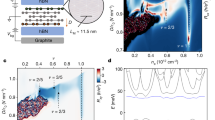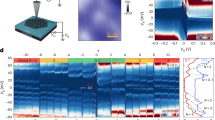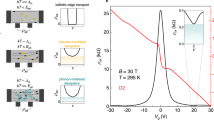Abstract
The fractional quantum Hall effect1,2,3,4 (FQHE) in an electron gas with multiple internal degrees of freedom provides a model system to study the interplay between symmetry breaking and emergent topological order5. In graphene, the structure of the honeycomb lattice endows the electron wavefunctions with an additional quantum number, termed valley isospin, which, combined with the usual electron spin, yields four-fold degenerate Landau levels (LLs; refs 6, 7). This additional symmetry modifies the FQHE and is conjectured to produce new incompressible ground states in graphene8,9,10,11,12,13,14,15,16,17. Here we report multiterminal measurements of the FQHE in high-mobility graphene devices fabricated on hexagonal boron nitride substrates18. The measured energy gaps are large, particularly in the second Landau level, where they are up to 10 times larger than those reported in the cleanest conventional systems. In the lowest Landau level the hierarchy of FQH states reflects the additional valley degeneracy.
This is a preview of subscription content, access via your institution
Access options
Subscribe to this journal
Receive 12 print issues and online access
$259.00 per year
only $21.58 per issue
Buy this article
- Purchase on SpringerLink
- Instant access to full article PDF
Prices may be subject to local taxes which are calculated during checkout



Similar content being viewed by others
References
Tsui, D. C., Stormer, H. L. & Gossard, A. C. Two-dimensional magnetotransport in the extreme quantum limit. Phys. Rev. Lett. 48, 1559–1562 (1982).
Laughlin, R. B. Anomalous quantum Hall effect: An incompressible quantum fluid with fractionally charged excitations. Phys. Rev. Lett. 50, 1395–1398 (1983).
Halperin, B. Theory of the quantized Hall conductance. Helv. Phys. Acta 56, 75–102 (1983).
Jain, J. K. Composite-fermion approach for the fractional quantum Hall effect. Phys. Rev. Lett. 63, 199–202 (1989).
Das Sarma, S. & Pinczuk, A. Perspectives in Quantum Hall Effects (Wiley, 1997).
Novoselov, K. et al. Two-dimensional gas of massless Dirac fermions in graphene. Nature 438, 197–200 (2005).
Zhang, Y., Tan, Y., Stormer, H. & Kim, P. Experimental observation of the quantum Hall effect and Berry’s phase in graphene. Nature 438, 201–204 (2005).
Toke, C., Lammert, P. E., Crespi, V. H. & Jain, J. K. Fractional quantum Hall effect in graphene. Phys. Rev. B 74, 235417 (2006).
Yang, K., Das Sarma, S. & MacDonald, A. H. Collective modes and skyrmion excitations in graphene SU(4) quantum Hall ferromagnets. Phys. Rev. B 74, 075423 (2006).
Nomura, K. & MacDonald, A. H. Quantum Hall ferromagnetism in graphene. Phys. Rev. Lett. 96, 256602 (2006).
Apalkov, V. M. & Chakraborty, T. Fractional quantum Hall states of Dirac electrons in graphene. Phys. Rev. Lett. 97, 126801 (2006).
Goerbig, M. O. & Regnault, N. Analysis of a SU(4) generalization of Halperin’s wave function as an approach towards a SU(4) fractional quantum Hall effect in graphene sheets. Phys. Rev. B 75, 241405 (2007).
Khveshchenko, D. V. Composite Dirac fermions in graphene. Phys. Rev. B 75, 153405 (2007).
Toke, C. & Jain, J. K. SU(4) composite fermions in graphene: Fractional quantum Hall states without analog in GaAs. Phys. Rev. B 75, 245440 (2007).
Shibata, N. & Nomura, K. Coupled charge and valley excitations in graphene quantum Hall ferromagnets. Phys. Rev. B 77, 235426 (2008).
Shibata, N. & Nomura, K. Fractional quantum Hall effects in graphene and its bilayer. J. Phys. Soc. Jpn 78, 104708 (2009).
Papić, Z., Goerbig, M. O. & Regnault, N. Atypical fractional quantum Hall effect in graphene at filling factor 1/3. Phys. Rev. Lett. 105, 176802 (2010).
Dean, C. R. et al. Boron nitride substrates for high-quality graphene electronics. Nature Nanotech. 5, 722–726 (2010).
Zhang, Y. et al. Landau-level splitting in graphene in high magnetic fields. Phys. Rev. Lett. 96, 136806 (2006).
Du, X., Skachko, I., Duerr, F., Luican, A. & Andrei, E. Y. Fractional quantum Hall effect and insulating phase of Dirac electrons in graphene. Nature 462, 192–195 (2009).
Bolotin, K. I., Ghahari, F., Shulman, M. D., Stormer, H. L. & Kim, P. Observation of the fractional quantum Hall effect in graphene. Nature 462, 196–199 (2009).
Checkelsky, J. G., Li, L. & Ong, N. P. Zero-energy state in graphene in a high magnetic field. Phys. Rev. Lett. 100, 206801 (2008).
Ghahari, F., Zhao, Y., Cadden-Zimansky, P., Bolotin, K. & Kim, P. Measurement of the ν=1/3 fractional quantum Hall energy gap in suspended graphene. Phys. Rev. Lett. 106, 046801 (2011).
Goerbig, M. O., Moessner, R. & Douçot, B. Electron interactions in graphene in a strong magnetic field. Phys. Rev. B 74, 161407 (2006).
Dethlefsen, A. F., Mariani, E., Tranitz, H-P., Wegscheider, W. & Haug, R. J. Signatures of spin in the ν=1/3 fractional quantum Hall effect. Phys. Rev. B 74, 165325 (2006).
Ando, T. Screening effect and impurity scattering in monolayer graphene. J. Phys. Soc. Jpn 75, 074716 (2006).
Kumar, A., Manfra, M. J., Csáthy, G. A., Pfeiffer, L. N. & West, K. W. Nonconventional odd denominator fractional quantum Hall states in the second Landau level. Phys. Rev. Lett. 105, 246808 (2010).
Padmanabhan, M., Gokmen, T. & Shayegan, M. Composite fermion valley polarization energies: Evidence for particle–hole asymmetry. Phys. Rev. B 81, 113301 (2010).
Lai, K., Pan, W., Tsui, D. C. & Xie, Y-H. Fractional quantum Hall effect at ν=2/3 and 4/3 in strained Si quantum wells. Phys. Rev. B 69, 125337 (2004).
Acknowledgements
We thank J. K. Jain, C. Toke, N. Shibata, M. O. Goerbig and M. Foster for discussions, J. Sanchez-Yamagishi and P. Jarillo-Herrero for fabrication advice regarding the PVA, and I. Meric, Z. Kagan, A. Tsoi, N. Baklitskaya and I. Mendonca for help with the device preparation. A portion of this work was performed at the National High Magnetic Field Laboratory, which is supported by National Science Foundation Cooperative Agreement No. DMR-0654118, the State of Florida and the US Department of Energy. This work is supported by DARPA CERA, AFOSR MURI, FCRP through C2S2 and FENA, NSEC (No. CHE-0117752) and NYSTAR. P.K. and A.F.Y. acknowledge support from DOE (DE-FG02-05ER46215).
Author information
Authors and Affiliations
Contributions
C.R.D. and A.F.Y. performed all experiments including sample fabrication and measurement, and wrote the paper. P.C-Z. contributed to sample measurement. L.W. and H.R. contributed to sample fabrication. K.W. and T.T. synthesized the h-BN samples. J.H., P.K. and K.L.S. advised on experiments.
Corresponding author
Ethics declarations
Competing interests
The authors declare no competing financial interests.
Supplementary information
Supplementary Information
Supplementary Information (PDF 199 kb)
Rights and permissions
About this article
Cite this article
Dean, C., Young, A., Cadden-Zimansky, P. et al. Multicomponent fractional quantum Hall effect in graphene. Nature Phys 7, 693–696 (2011). https://doi.org/10.1038/nphys2007
Received:
Accepted:
Published:
Issue Date:
DOI: https://doi.org/10.1038/nphys2007
This article is cited by
-
Broken symmetries and excitation spectra of interacting electrons in partially filled Landau levels
Nature Physics (2023)
-
Boron-doped armchair germanene nanoribbons with a width of six atoms in an external field: a DFT study
Journal of Molecular Modeling (2023)
-
Size dependence- and induced transformations- of fractional quantum Hall effects under tilted magnetic fields
Scientific Reports (2022)
-
Fractional Processes and Their Statistical Inference: An Overview
Journal of the Indian Institute of Science (2022)
-
Global strain-induced scalar potential in graphene devices
Communications Physics (2021)



